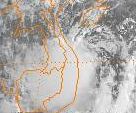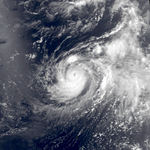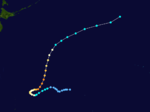1984 Pacific typhoon season
| 1984 Pacific typhoon season |

Season summary map
|
| Seasonal boundaries |
| First system formed |
June 7, 1984 |
| Last system dissipated |
December 12, 1984 |
| Strongest storm |
|
| Name |
Vanessa |
| • Maximum winds |
220 km/h (140 mph)
(10-minute sustained) |
| • Lowest pressure |
880 hPa (mbar) |
|
| Seasonal statistics |
| Total depressions |
44 |
| Total storms |
27 |
| Typhoons |
16 |
| Super typhoons |
2 |
| Total fatalities |
2,919 |
| Total damage |
> $1.1 billion (1984 USD) |
| Related articles |
|
|
Pacific typhoon seasons
1982 1983 1984 1985 1986
|
| Tropical storm (JMA) |
| Tropical storm (SSHWS) |
|
|
| Duration |
June 7 – June 11 |
| Peak intensity |
75 km/h (45 mph) (10-min) 994 hPa (mbar) |
| Severe tropical storm (JMA) |
| Tropical storm (SSHWS) |
|
|
| Duration |
June 18 – June 27 |
| Peak intensity |
100 km/h (65 mph) (10-min) 980 hPa (mbar) |
| Typhoon (JMA) |
| Category 1 typhoon (SSHWS) |
|
|
| Duration |
July 1 – July 4 |
| Peak intensity |
150 km/h (90 mph) (10-min) 960 hPa (mbar) |
| Severe tropical storm (JMA) |
| Tropical storm (SSHWS) |
|
|
| Duration |
July 4 – July 10 |
| Peak intensity |
95 km/h (60 mph) (10-min) 985 hPa (mbar) |
| Typhoon (JMA) |
| Category 2 typhoon (SSHWS) |
|
|
| Duration |
July 6 – July 17 |
| Peak intensity |
150 km/h (90 mph) (10-min) 955 hPa (mbar) |
| Typhoon (JMA) |
| Category 4 typhoon (SSHWS) |
|
|
| Duration |
July 24 – August 1 |
| Peak intensity |
185 km/h (115 mph) (10-min) 915 hPa (mbar) |
| Typhoon (JMA) |
| Category 3 typhoon (SSHWS) |
|
|
| Duration |
July 24 – August 2 |
| Peak intensity |
150 km/h (90 mph) (10-min) 950 hPa (mbar) |
| Severe tropical storm (JMA) |
| Tropical storm (SSHWS) |
|
|
| Duration |
August 4 – August 10 |
| Peak intensity |
95 km/h (60 mph) (10-min) 985 hPa (mbar) |
| Tropical depression (JMA) |
| Tropical depression (SSHWS) |
|
|
| Duration |
August 11 – August 13 |
| Peak intensity |
55 km/h (35 mph) (10-min) 996 hPa (mbar) |
The 1984 Pacific typhoon season has no official bounds, but most tropical cyclones tend to form in the northwestern Pacific Ocean between May and November. These dates conventionally delimit the period of each year when most tropical cyclones form in the northwestern Pacific Ocean. Tropical Storms formed in the entire west pacific basin were assigned a name by the Joint Typhoon Warning Center. Tropical depressions that enter or form in the Philippine area of responsibility are assigned a name by the Philippine Atmospheric, Geophysical and Astronomical Services Administration or PAGASA. This can often result in the same storm having two names.
A total of 30 tropical depressions formed in 1984 in the Western Pacific, of which 27 became tropical storms, 16 reached typhoon intensity, and two reached super typhoon strength. Eight tropical cyclones moved into mainland China, four struck Vietnam, four moved through the Philippines, and one cyclone moved into South Korea. The second consecutive typhoon season with a late start, all of the season activity was contained between June and December, with August and October the most active months, contributing to half of the seasonal tropical cyclone count.
Despite its late start, a total of 30 tropical depressions formed this year in the Western Pacific, of which 27 became tropical storms. A total of 16 storms reached typhoon intensity, of which 2 reached super typhoon strength. Three of the systems formed in June, four in July, seven in August, four in September, eight in October, three in November, and one in December. Eight tropical cyclones moved into mainland China, four struck Vietnam, four moved through the Philippines, and one cyclone moved into South Korea. The most damaging and deadly typhoon this season was Ike, which led to significant damage and two-thirds of the overall seasonal death toll, mainly from the Philippines. The longest lived cyclone was Bill, which persisted for two weeks during mid November. Despite the eight tropical cyclones moving into China, Hong Kong received only 18 percent of its annual rainfall from tropical cyclones, which was 35 percent below the annual average.
...
Wikipedia



















